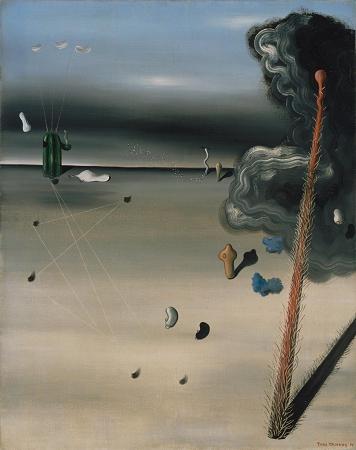Giorgio de Chirico (1888 - 1978). Giorgio de Chirico was an Italian artist and writer born in Greece. In the years before World War I, he founded the scuola metafisica art movement, which profoundly influenced the surrealists. His most well-known works often feature Roman arcades, long shadows, mannequins, trains, and illogical perspective. His imagery reflects his affinity for the philosophy of Nietzsche and for the mythology of his birthplace. After 1919, he became a critic of modern art, studied traditional painting techniques, and worked in a neoclassical or neo-Baroque style, while frequently revisiting the metaphysical themes of his earlier work. De Chirico was born in Volos, Greece, as the eldest son of Gemma Cervetto and Evaristo de Chirico. His mother was Genoese-Greek and his father a Sicilian barone from a family of remote Greek origin. De Chirico's family was in Greece at the time of his birth because his father, engineer, was in charge of the construction of a railroad. Beginning in 1900, de Chirico studied drawing and painting at Athens Polytechnic, mainly under the guidance of the Greek painters Georgios Roilos and Georgios Jakobides. After Evaristo de Chirico's death in 1905, the family relocated in 1906 to Germany, after first visiting Florence. De Chirico entered the Academy of Fine Arts in Munich, where he studied under Gabriel von Hackl and Carl von Marr and read the writings of the philosophers Nietzsche, Arthur Schopenhauer and Otto Weininger. There, he also studied the works of Arnold Bocklin and Max Klinger. The style of his earliest paintings, such as The Dying Centaur, shows the influence of Bocklin. De Chirico returned to Italy in the summer of 1909 and spent six months in Milan. By 1910, he was beginning to paint in a simpler style of flat, anonymous surfaces. At the beginning of 1910, he moved to Florence where he painted the first of his Metaphysical Town Square series, The Enigma of an Autumn Afternoon, after the revelation he felt in Piazza Santa Croce. He also painted The Enigma of the Oracle while in Florence. In July 1911 he spent a few days in Turin on his way to Paris. De Chirico was profoundly moved by what he called the 'metaphysical aspect' of Turin, especially the architecture of its archways and piazzas. The paintings de Chirico produced between 1909 and 1919, his metaphysical period, are characterized by haunted, brooding moods evoked by their images. At the start of this period, his subjects were motionless cityscapes inspired by the bright daylight of Mediterranean cities, but gradually he turned his attention to studies of cluttered storerooms, sometimes inhabited by mannequin-like hybrid figures. De Chirico's conception of Metaphysical art was strongly influenced by his reading of Nietzsche, whose style of writing fascinated de Chirico with its suggestions of unseen auguries beneath the appearance of things. De Chirico found inspiration in the unexpected sensations that familiar places or things sometimes produced in him: In a manuscript of 1909 he wrote of the host of strange, unknown and solitary things that can be translated into painting. What is required above all is a pronounced sensitivity. Metaphysical art combined everyday reality with mythology, and evoked inexplicable moods of nostalgia, tense expectation, and estrangement. The picture space often featured illogical, contradictory, and drastically receding perspectives. Among de Chirico's most frequent motifs were arcades, of which he wrote: The Roman arcade is fate. its voice speaks in riddles which are filled with a peculiarly Roman poetry. De Chirico moved to Paris in July 1911, where he joined his brother Andrea. Through his brother he met Pierre Laprade, a member of the jury at the Salon d'Automne, where he exhibited three of his works: Enigma of the Oracle, Enigma of an Afternoon and Self-Portrait. During 1913 he exhibited paintings at the Salon des Independants and Salon d'Automne; his work was noticed by Pablo Picasso and Guillaume Apollinaire, and he sold his first painting, The Red Tower. His time in Paris also resulted in the production of Chirico's Ariadne. In 1914, through Apollinaire, he met the art dealer Paul Guillaume, with whom he signed a contract for his artistic output. At the outbreak of World War I, he returned to Italy. Upon his arrival in May 1915, he enlisted in the army, but he was considered unfit for work and assigned to the hospital at Ferrara. The shop windows of that town inspired a series of paintings that feature biscuits, maps, and geometric constructions in indoor settings. In Ferrara he met with Carlo Carra and together they founded the pittura metafisica movement. He continued to paint, and in 1918, he transferred to Rome.
more...













